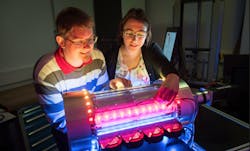Promising 'Muscle' Wire Offers Alternative for Refrigeration
Last August, I wrote about the new refrigerant rules in Section 608 of the U.S. Clean Air Act. Vapor-compression refrigeration, upon which most air conditioning systems rely, obviously requires a refrigerant to function. But what if we could heat and cool our indoor environment – and our domestic water – with “muscle”?
No, I’m not advocating that all AC techs with EPA 608 cards have to do CrossFit! These muscles are made from metal alloy wire.
Researchers at Saarland University, a research university located in Saarbrucken, Germany, have developed a device that uses “muscle wire” made from nickel-titanium, a shape-memory alloy, for heat transfer. When the nickel-titanium “muscle” is mechanically loaded, it releases heat to the environment. Then, when it is unloaded, it absorbs heat from its surrounding air or water (or other fluid). For those not familiar with shape-memory metals, these are alloys that remember their original shape and, after being deformed, can return to their pre-deformed shape.
Students Welsch (left) and Susanne Marie Kirsch with the first-ever machine that cools air with 'muscles' of nickel-titanium. Credit: Oliver Dietze
Both the U.S. Dept. of Energy and the EU Commission have determined this technology to be “the most promising alternative technology to existing vapor-compression refrigeration systems.” The prototype device built by the Saarland team has been cooling air by continuously loading and unloading muscle wire bundles using a cam-driven mechanism. As the warm air is blown through one chamber, it is cooled, while the air in the other chamber is heated. In addition to being environmentally-friendly, since it uses no refrigerants, it is claimed to be two to three times more efficient than conventional HVAC systems.
According to Prof. Stefan Seelecke, Saarland University’s Chair in Intelligent Material Systems, the nickel-titanium’s crystal lattice structure absorbs and releases latent heat as it is cycled. One of the research team members, doctoral candidate Felix Welsch, noted that when pre-stressed muscle wire was unloaded at room temperature, it cooled down by as much as 20 degrees. The technology could be used to replace convention straight-cool or heat pump equipment, and eliminates the need for high-pressure piping or intermediate heat exchangers. By using wire bundles, the surface area can be increased, resulting in faster, more efficient cooling.
The theory of operation sounds simple enough, but development of a commercially-viable system will take a while. The Saarland team has been working on this for years and is currently doing computer modelling, using software they developed, to move the research forward. We should all stay tuned.
A regular contributor to HPAC Engineering and a member of its editorial advisory board, the author is a principal at Sustainable Performance Solutions LLC, a south Florida-based engineering firm focusing on energy and sustainability. For more, click here.
About the Author
Larry Clark
A member of HPAC Engineering’s Editorial Advisory Board, Lawrence (Larry) Clark, QCxP, GGP, LEED AP+, is principal of Sustainable Performance Solutions LLC, a South Florida-based engineering firm focused on energy and sustainability consulting. He has more than two dozen published articles on HVAC- and energy-related topics to his credit and frequently lectures on green-building best practices, central-energy-plant optimization, and demand-controlled ventilation.

